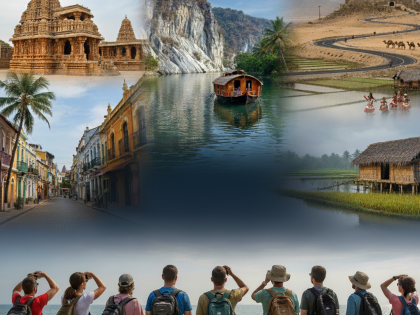Unlocking India’s Tourism Potential: Challenges and Opportunities
By Lokmat Times Desk | Updated: September 24, 2025 07:32 IST2025-09-24T07:28:52+5:302025-09-24T07:32:43+5:30
India is extraordinarily diverse with its vibrant cultures, diverse geography, and world-famous heritage. With a history that goes back several millennia ...

Unlocking India’s Tourism Potential: Challenges and Opportunities
India is extraordinarily diverse with its vibrant cultures, diverse geography, and world-famous heritage. With a history that goes back several millennia it is often imagined as one of the most attractive destinations for global travelers. Yet, the reality tells a different story. Despite covering an area of 32,87,263 sq. km and possessing everything that tourists desire, ranging from the cultural coastal town of Kovalam in Kerala to the high peaks of the Lushai Hills in Mizoram among many other glorious destinations, India hosted only 18.89 million tourists in 2023, according to the Ministry of Tourism. For a nation with such vibrant cultures and geographical diversity, this statistic emphasizes not India’s progress, but rather the immense untapped potential of the tourism industry in India.
Although India is home to many UNESCO World Heritage Sites such as the intricate Hoysala Temples in Karnataka, it offers other breathtaking and historical sites beyond the UNESCO list. From the colorful Portuguese-era architecture of Panaji in Goa and the shimmering and iconic marble cliffs of Bhedaghat near Jabalpur to the calm backwaters of Kerala and the unadulterated Majuli Island in Assam, India’s diversity is unmatched. Combine this with the spiritual and adrenaline-filled Spiti and Nubra valleys in North India, and it becomes evident that India’s huge untapped potential for tourism lies as much in its unknown destinations as in its famous and iconic monuments.
However, despite its immense cultural and geographical diversity, India’s tourism industry remains underdeveloped. A major drawback lies in infrastructure. Although India has many state-of-the-art airports, connectivity to the hidden gems of India remains unreliable, which discourages tourists, especially foreign visitors, from exploring beyond the world-renowned regions of Mumbai, Delhi, and Jaipur. Meanwhile, regions such as the Northeast and Central India, with their unique landscapes, remain absent from tourists’ bucket lists due to limited accessibility and promotion.
Similarly, India has failed to take full advantage of niche tourism segments such as adventure tourism and cruise tourism, which are extremely popular in countries that are much smaller and lacking in resources than India, such as New Zealand and countries in the Caribbean. Another constraint lies in digital integration. Although the popularity of online booking platforms in India is now greater than ever, India still lacks globally marketed systems that facilitate planning and showcase undiscovered destinations to international audiences. These unexplored opportunities reveal that while India is rich in attractions, it lacks the infrastructure, branding, and global recognition required to transform its tourism sector into a true powerhouse.
Other factors hindering India’s tourism development include several social and organizational challenges that prevent India from reaching its full potential in terms of tourism. Policy and regulatory hurdles such as bureaucratic delays and corruption often make it difficult for businesses to invest openly in tourism infrastructure while also discouraging foreign visitors who fear for their well-being. Safety and hygiene concerns also play an important role, particularly for female travellers. These concerns continue to form strong negative opinions among international visitors who, as a result, choose to omit India from their bucket lists.
Environmental degradation and unsustainable practices such as littering and overcrowding of popular destinations and public spaces threaten the very resources that attract tourists. Additionally, global competition from countries with more streamlined and cleaner tourist experiences, such as Indonesia and the UAE, means that India must bring about social and institutional changes in order to capitalize on its vast opportunities in tourism. These challenges highlight the need for sustainable practices and policy reforms to unlock India’s tourism potential.
To fully realize its tourism potential, India must intervene in areas such as infrastructure, policy reforms, and marketing. Public-Private Partnerships could offer a path for developing infrastructure leading to hidden gems, developing heritage sites, and potentially allowing India to take advantage of tourism niches. Marketing and branding are also very important.
India could follow successful campaigns such as Rwanda’s “Visit Rwanda” initiative, which has made Rwanda a top destination for eco-tourism and international conferences. Similarly, Malta’s “Visit Malta” campaign perfectly highlights its Mediterranean culture and beauty, which has garnered significant international attention. India could follow in their footsteps, creating region-specific campaigns that glorify destinations such as Jabalpur and Majuli Island, while also improving digital integration, which could significantly increase the number of foreign tourists visiting India.
Lastly, promoting domestic tourism alongside international tourism could create a safety net for local tourism-reliant economies. With strategic investment and marketing practices, India can turn its historical but under-leveraged tourism economy into a globally recognized hub.
In summary, India’s enormous cultural and geographic riches present unmatched tourism opportunities, but much of its potential has not yet been realized. India has attractions that can compete with those of any other nation in the world, from the famous monuments and UNESCO sites to the lesser-known destinations of Panaji, Jabalpur, and Majuli Island. Its reach is still constrained by issues with global marketing, safety, sustainability, policy, and infrastructure.
Through the implementation of sustainable practices, public-private partnerships, enhanced connectivity, and strategic, globally targeted marketing campaigns like “Visit Rwanda,” India can turn its tourism industry into a prosperous, internationally renowned one. In addition to promoting economic growth, realizing this potential would honor and spread awareness of India’s remarkable natural and cultural heritage.
This article is authored by Mr. Kanav Jain.
Open in app